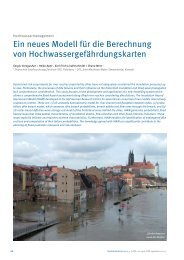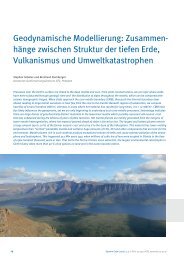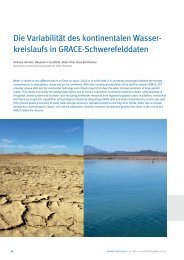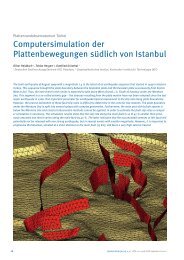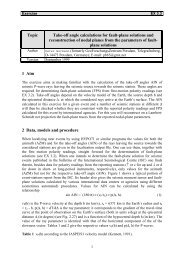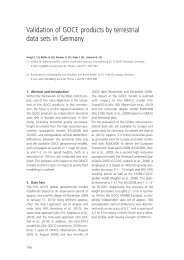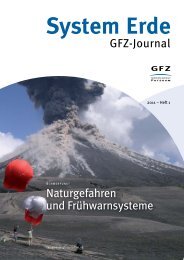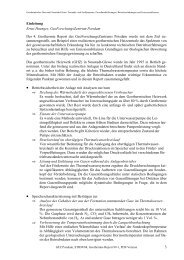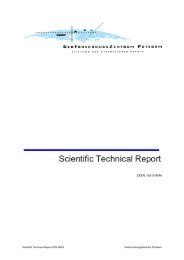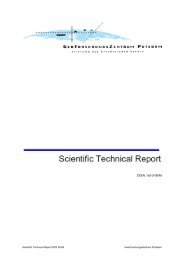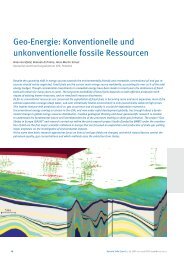2 Seismic Wave Propagation and Earth models
2 Seismic Wave Propagation and Earth models
2 Seismic Wave Propagation and Earth models
Create successful ePaper yourself
Turn your PDF publications into a flip-book with our unique Google optimized e-Paper software.
2. <strong>Seismic</strong> <strong>Wave</strong> <strong>Propagation</strong> <strong>and</strong> <strong>Earth</strong> <strong>models</strong><br />
Young’s modulus, the bulk modulus <strong>and</strong> the shear modulus all have the same physical units<br />
as pressure <strong>and</strong> stress, namely (in international st<strong>and</strong>ard (SI) units):<br />
1 Pa = 1 N m -2 = 1 kg m -1 s -2 (with 1 N = 1 Newton = 1 kg m s -2 ). (2.1)<br />
2.2.2 Stress-strain relationship<br />
The most general linear relationship between stress <strong>and</strong> strain of an elastic medium is<br />
governed in the generalized Hook’s law (see Eqation (10) in the IS 3.1) by a fourth order<br />
parameter tensor. It contains 21 independent moduli. The properties of such a solid may vary<br />
with direction. Then the medium is called anisotropic. Otherwise, if the properties are the<br />
same in all directions, a medium is termed isotropic. Although in some parts of the <strong>Earth</strong>’s<br />
interior anisotropy on the order of a few percent exists, isotropy has proven to be a reasonable<br />
first-order approximation for the <strong>Earth</strong> as a whole. The most common <strong>models</strong>, on which data<br />
processing in routine observatory practice is based, assume isotropy <strong>and</strong> changes of properties<br />
only with depth.<br />
In the case of isotropy the number of independent parameters in the elastic tensor reduces to<br />
just two. They are called after the French physicist Lamé (1795-1870) the Lamé parameters λ<br />
<strong>and</strong> μ. The latter is identical with the shear modulus. λ does not have a straightforward<br />
physical explanation but it can be expressed in terms of the above mentioned elastic moduli<br />
<strong>and</strong> Poisson’s ratio, namely<br />
σ E<br />
λ = κ - 2μ /3 =<br />
. (2.2)<br />
( 1 + σ )( 1 − 2σ<br />
)<br />
The other elastic parameters can also be expressed as functions of μ, λ <strong>and</strong>/or κ:<br />
<strong>and</strong><br />
( 3λ<br />
+ 2μ)<br />
μ<br />
E =<br />
(2.3)<br />
( λ + μ)<br />
λ<br />
σ =<br />
2( λ + μ)<br />
3κ<br />
− 2μ<br />
= . (2.4)<br />
2(<br />
3κ<br />
+ μ)<br />
For a Poisson solid λ = μ <strong>and</strong> thus, according to (2.4), σ = 0.25. Most crustal rocks have a<br />
Poisson’s ratio between about 0.2 <strong>and</strong> 0.3. But σ may reach values of almost 0.5, e.g., for<br />
unconsolidated, water-saturated sediments, <strong>and</strong> even negative values of σ are possible (see<br />
Tab. 2.1).<br />
The elastic parameters govern the velocity with which seismic waves propagate. The equation<br />
of motion for a continuum can be written as<br />
∂<br />
2<br />
i ρ 2<br />
∂t<br />
u<br />
= ∂ jτ<br />
ij + f i , (2.5)<br />
4



